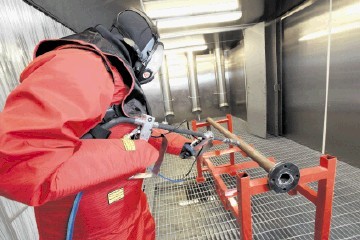
Waste disposal in the UK offshore industry is getting better, but the sector’s ageing assets are keeping operators and waste contractors on their toes.
According to figures from Oil & Gas UK, waste going to landfill from UK North Sea installations has dropped from 51% of waste to 33% between 2000 and 2011, with recycling and reuse increasing from 19% of waste to 33% in the same period.
Increasing quantities are also being used for waste to energy schemes, rising from 2% to 11% of the basin’s offshore waste disposal between 2000 and 2011.
However, changing legislation and increasing amounts of hazardous material being produced from offshore has made disposal an ever more complex task.
High on the agenda has been NORM waste – normally occurring radioactive material – and mercury, a heavy metal.
Anne Bishop, commercial manager at Asco-owned waste management firm Enviroco, said she had seen inquiries for NORM and mercury waste rise from five in the first quarter of 2011 to 26 in the same period this year.
It is frequently coming from offshore equipment and tubulars, stripped out for recycling or reuse and from which scale, the source of the NORM and mercury waste, has to be removed, as well as sand and pig wax.
It is thought to be increasing due to the age of wells now in the UK North Sea and also the depths wells are now being drilled to, said Bishop.
Last year new rules around NORM waste also came into force in Scotland, stopping a previous practice of disposing of waste scale in the sea. Historically, there had been dumping off Aberdeen.
The new rules have sparked a flurry of new facilities to deal with the waste – Enviroco’s joint venture with John Lawrie, NORM Solutions, in Aberdeen, and Nuvia’s Nuvia SITA NORM facility near Peterhead.
These strip the scale off equipment, which can then be reused or recycled, and the NORM and or mercury waste sent to approved landfill sites.
Ron Smith, manager oil and gas services at Nuvia, said: “NORM tends to increase as wells get older. Most of the hazardous waste tends to increase as wells get older and operators have to put more water through. In most of the North Sea now wells are getting fairly old.”
Taqa Bratani’s environmental lead Alastair Maclean thinks the rise in levels is more a reflection of an increase in activity in the basin and awareness.
There is also a concern that diverting waste to “landfill is solving one problem but creating another”. In the UK waste mercury mostly goes to approved landfill sites.
Bishop says a better option would be taking it to the waste plants in Germany, where the mercury is recovered for reuse.
However, there is legislation which does not permit waste left over from that process re-entering the UK – and with Germany not wishing to keep it that option is out, she said.
An additional issue in the UK is that there are only two high temperature incinerators – used for some mercury waste disposal, leading to higher prices and capacity constraints.
The industry is looking at its options, she said.
However, introducing new methods of waste disposal is not always easy, according to TWMA’s Rob ONeill.
TWMA, based in Aberdeen, has been promoting an offshore drilling cuttings service disposal system, Rotomill, used offshore since 2003.
Since rules effectively prevented oil-based mud cuttings being dumped at sea, oil-based cuttings not re-injected into wells are brought to shore for processing and usually landfill.
But TWMA says this transportation of the waste is an unnecessary risk and just moving the problem. Rotomill thermally removes oil and water from cuttings before crushing the remaining solids to powder for offshore disposal.
But while TWMA is now helping Norway’s oil industry body look into offshore drilling cuttings waste disposal, O’Neill said the Rotomill is still perceived as new technology and there was a feeling of reluctance to change current procedures.
Other ways of improving offshore waste management, especially general waste, is increased and better segregation offshore and better analysis of waste before it is brought onshore, said Bishop.
Also, especially in decommissioning, early involvement of waste management firms before work starts so there are no unnecessary stoppages to work – it can take 30 days to analyse some NORM waste, she said.
For waste contractors most of the issues that will be involved in decommissioning are well known, said Smith. “There is more work going in to characterising volumes and anticipated volumes,” he said, the big uncertainty being capacity to deal with the waste.
Operators, and their environmental representative (e-reps) are taking notice – Taqa Bratani holds quarterly meetings to see how it can improve its waste disposal and is currently piloting a test to see if it can reuse material used in garnet blasting, a method of removing paintwork off facilities.
There is also a ground up move to improve processes – the first inter-company forum of e-reps at operators is being held in Aberdeen this month, offering reps a chance to share ideas and best practice.